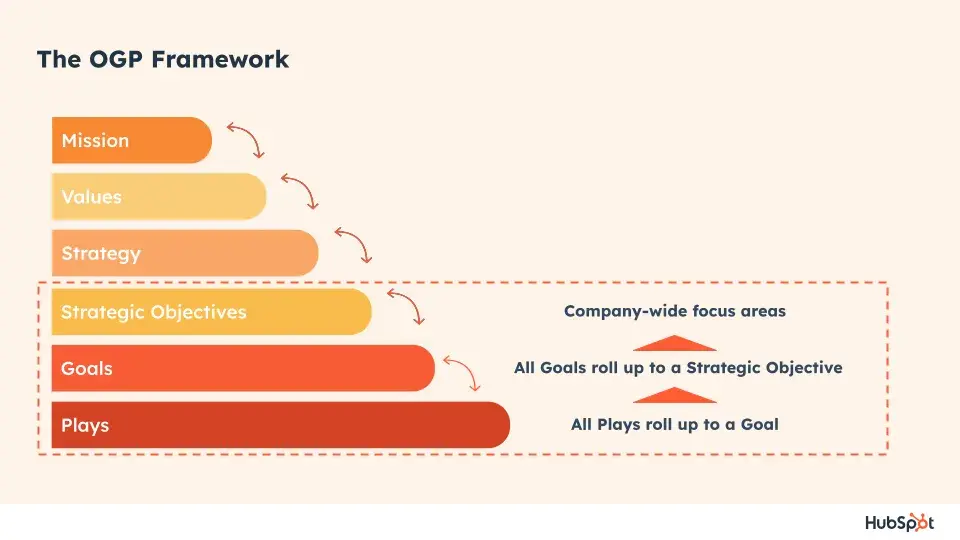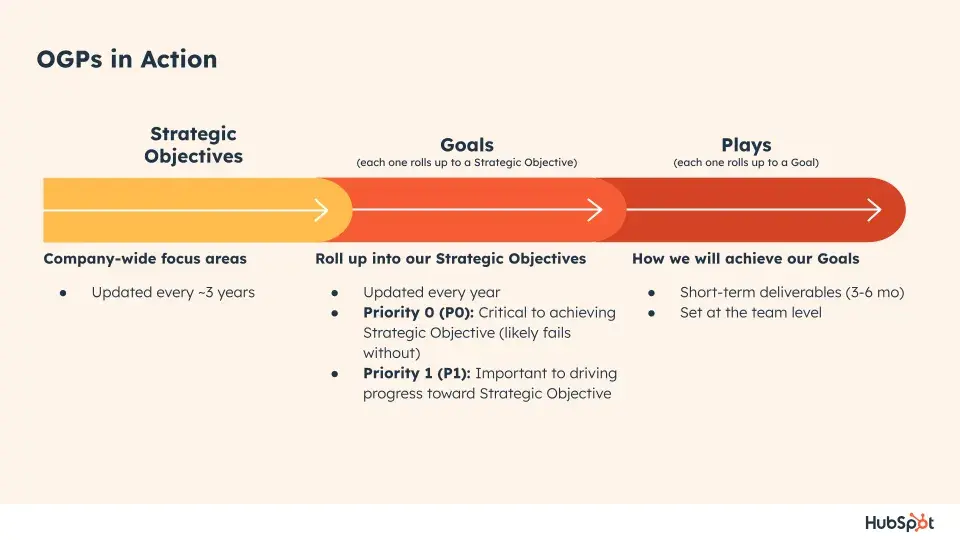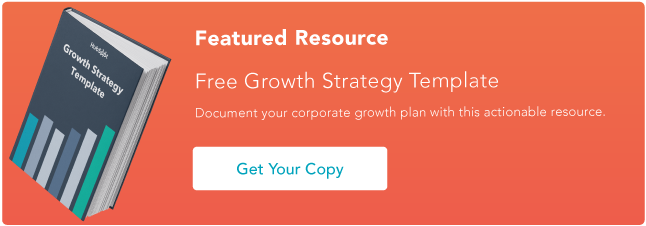There are so many things you can do to move the needle, but which ones should you act on? With so many people working on so many projects, how do you keep everyone moving in the same direction?
Unlocking these answers is the difference between disconnected work efforts and forward progress to achieve your mission.
As we continue to scale, we need to encourage self-motivation and execute on more cross-functional work to help our customers drive growth.
But let’s face it — autonomy without alignment leads to chaos.
That's where the OGP framework comes in. Your strategy is only as good as how you execute against it. And having a framework to enable aligned execution is critical.
Ours allows us to continue providing autonomy with clear alignment on priorities from the top.
The OGP Framework
OGP stands for Objectives, Goals, and Plays.
Before you start identifying your OGPs, you have to understand your mission, your values, and align on the strategy that guides you.
Think of it as your operating system. These are the elements that will inform your Objectives and help you understand what success looks like at each milestone.
And all of this is driven by who you serve — your customers, your buyer persona, the people you’re ultimately solving for.
Our executive team uses the following slide to drive our OGPs from the top:

- Mission: What is our big-picture vision?
- Values: What beliefs and principles drive the way we work?
- Strategy: How are we going to reach our vision?
- Strategic Objectives: What long-term, company-wide bets are we making over the next ~3 years
- Goals: How will we accomplish our objectives at the functional level over the next 12-18 months?
- Plays: How will we achieve our goals at the team level through specific deliverables over the next 3-6 months?
Your Mission and Values don’t change very often (if at all). They stay pretty consistent year to year.
Your Strategy and Strategic Objectives change roughly every three years. Each year at HubSpot, we review our Objectives from the previous year and decide whether we’re going to keep them consistent for the upcoming year.
On the other hand, your Goals and Plays get updated more frequently. We update our Goals every year and revisit our Plays on a half-yearly or quarterly basis.
More on OGPs
Alignment starts with an understanding of our long-term strategy, and our Strategic Objectives are determined at the executive level.
We choose to stack rank our Objectives to provide clear prioritization for the whole business. For example, we have seven Strategic Objectives for 2025, and we have them organized by order of importance.
Why? To make sure our teams have a clear sense of priorities and guidance on how to make necessary trade-offs.
Each Objective has a certain amount of Goals associated with it. We like to categorize our Goals based on priority:
- Priority 0 (P0): Critical to achieving Strategic Objective (likely fails without). There are fewer of these (~5 per Objective). They are often highly cross-functional, and these goals are reviewed by our C-suite on a monthly basis to ensure progress and remove any blockers.
- Priority 1 (P1): Important to driving progress toward Strategic Objective. There are more of these (~20 per Objective). They are often specific to one function, and these goals are reviewed by our functional leaders on a monthly basis to ensure progress and remove any blockers.
Then, there are Plays that roll up into each Goal. These are associated with the “how” — the specifics around what you’re going to do to accomplish your Goals.

Sounds like a lot of work, right? It is, but trust me — it’s worth it.
An important way to keep things running smoothly is through accountability. One critical way we’re holding people accountable is through our refreshed DRI model.
The DRI Model
In the OGP framework, the DRI (or Directly Responsible Individual) is the one person responsible for moving a Strategic Objective forward. They set the vision for the objective, define the success metrics and work to be done, align cross-functional teams, and navigate any blockers that arise.
Accountability and transparency are the keys to understanding whether we’re actually executing our strategy throughout the year.
We use mechanisms — like Quarterly Business Reviews (QBRs) and monthly reports — to create space for status updates, address blockers proactively, and ensure we’re hitting our milestones.
So, there you have it. Just pop some ideas onto a few slides, and you can check strategic planning off your list!
… not so fast.
OGPs are a means to an end. They can help create focus, but true alignment comes from doing the hard work of thinking, planning, and communicating.
For us, the strategic direction is set by the executive team, but the execution of that strategy is very bottoms-up. Every VP is working with their directors, managers, and individual contributors to solve the “how” of each goal.
This is where the alignment from the top meets the autonomy of functional experts — and this is where the power of OGPs comes from.
How We Make OGPs Work For Us
At the core of strategic planning at HubSpot, we set out to identify the most important problems to solve for our customers. This allows us to focus our energy on the work that matters and align our teams on the work to be done.
The HEART of Success
What really works for us throughout this whole process is this: Direction and clarity about our priorities comes from the executive level, but the whole company is involved in the “how.”
Everyone at HubSpot is an important part of strategic planning.
Our Goal Drivers are collaborating with their teams to write memos that outline why their goals are important, how we’re going to achieve them, and what resources are needed to be successful.
And our executive leaders are setting direction at the highest view.
That’s how we create focus and alignment at every level of organization.
How We Continue to Evolve
Our approach to strategic planning evolves every year. It’s important that we tweak our framework based on new learnings and feedback from our employees.
We’re constantly using data to hold ourselves accountable to the strategy we laid out as a company. For example, we conduct eNPS surveys and interviews with people around the business to understand where we’re excelling and where we’re coming up short.
It’s comforting to slap an “approved” framework onto your business. It gives you a lot of confidence, but you can’t just stop there. You need to figure out what works for you as the industry grows and your customer needs evolve.
Focus doesn’t just happen. It’s a byproduct of shared vision. And vision comes from talking, sharing, looking at data, and updating assumptions.
If you’re not doing that work upfront, don’t bother with OGPs or any other goal-setting framework. None of them will work.
Give It a Try
In our culture code, we talk about hiring people with HEART (Humble, Effective, Adaptable, Remarkable, Transparent). We define effective as people who get sh*t done and take ownership for their success. You might also call this autonomy.
And in an autonomous culture, people can only thrive when they have a clear direction on where the company is going. This is where so many companies end up wasting top talent.
Focus and alignment are everything — and our framework is an incredibly valuable tool to keep employees focused on the path forward.
This post was adapted from MSPOTs: the Secret to Focus and Alignment, and has been updated for accuracy and comprehensiveness.
.png?width=112&height=112&name=Image%20Hackathon%20%E2%80%93%20Vertical%20(56).png)

.png)
